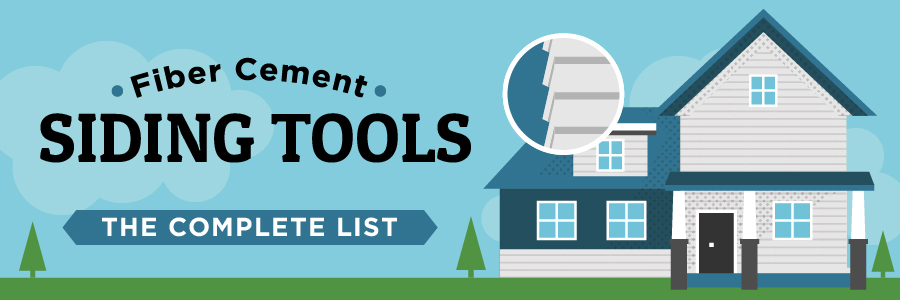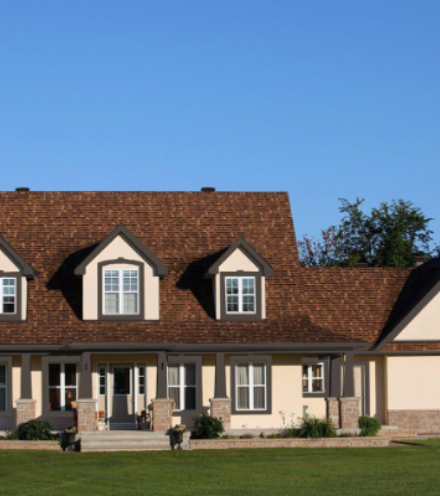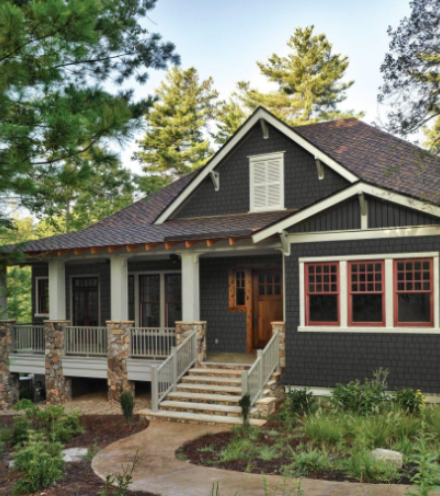
Fiber cement siding could be called the best of the best in the industry. For example, it features the looks of wood without the reactivity to moisture and humidity. Fiber cement can also emulate the appearance of stone but at a much lighter weight and without the high costs. The product also is relatively in line with the price of vinyl, but with much more durability and with an unmatchable upgrade in aesthetics.
In a nutshell, the fiber cement industry is booming as consumers are becoming more and more aware of the benefits of this stylish product. Therefore as a construction contractor or exterior renovator it's important to offer your customers fiber cement as an option. In most residential homes the product installs in a familiar lap form that is very similar to hanging cedar and other wood siding. One of the great things about fiber cement siding is the choices it provides homeowners with other installation styles including architectural panels, siding & shakes, vertical panels, and more.
Besides the knowledge of how to install the fiber cement, which will come with experience, what contractors need to provide this product to their customers is tools. Fiber cement is a mixture of wood pulp and concrete, which creates durability and weather resistance – but is also a little tricky to work with. The material creates an incredible amount of debris when using traditional woodworking hardware but luckily there are fiber cement tools to avoid that. Gauges, special blades, and other items help streamline the cutting and hanging of fiber cement so that it can be a one-person, tidy job.
Fiber Cement Shears & Attachments
For a one-time job a contractor could probably get away with using the tools in their trailer to work with fiber cement siding although it will create a lot of dust and may not produce the cleanest of cuts. For long term, regular work with this material though a few additions to the trailer are recommended:
Shear attachments – Most contractors have at least one screw gun in their tool arsenal. These devices are handy because of the multiple attachments that can transform the tool, one of which is a fiber cement shear attachment. Some version of a shear is necessary to cut the fiber cement in a straight line but also with little to no dust production while doing so.
Shear devices – For most significantly sized fiber cement jobs using a shear attachment on a cordless driver will leave you changing the battery more than you'll be pounding nails. In this instance an electric or pneumatic shear purchase can pay itself off rather quickly in increased production. The big differences within this line of product include the amperage and the capacity for the product thickness (usually up to 5/8”).
If you're not familiar with them, the company PacTool is devoted almost exclusively to fiber cement related tools. Malco is another leading manufacturer in regards to cutting the products and some of the more recognizable brands like Makita or DeWalt have their versions of shears and attachments available as well.
Kett P-1092 1/2-Inch Pneumatic Fiber-Cement Shears
Kett 95-20 Shear Head Blue Steel for 5/8-Inch Fiber-Cement Shear
Makita JS800 Variable Speed Fiber Cement Shear Kit
PacTool International SS204 Fiber Cement Siding Shear
Pactool International SS402 Fiber Cement Shear
Pactool International SS404 SteelHead Fiber Cement Cutting Shear
DEWALT D28605 5/16-Inch Variable Speed Fiber Cement Siding Shear
Malco TSf1A Turboshear Pneumatic Fiber Cement Siding Shear
Malco Tools TurboShear For Fiber Cement Siding With Carrying Case ma
Pactool International SS414 Fiber Cement Curve Shear
Pactool International SS414 Fiber Cement Curve Shear
Pactool International SS504 Cordless Fiber Cement Siding Shear
Malco TSFC Turbo Shear Fiber Cement Cutting Shear Attachment
Kett Tool KD-1493 Fiber-Cement Shears
Kett KD-1495 5/8-Inch Fiber-Cement Shears
Plank & Trim Cutters
Shears are necessary for fiber cement installation mainly because they produce less debris and can create versatile cuts. Any contractor will tell you though that the biggest downfall in using the shears is the speed, or lack thereof. Circular saws with a dust collector are an easy fix to this but so are specialty cutters like those that you might find in the asphalt shingle installation or flooring-laying fields.
Most of the devices work like a guillotine creating crisp, clean, cuts with one swipe down of the blade. These products are also useful for cutting window and edge trim where straight cuts are mandatory because they are exposed. The size of the models (9”, 13”, 20”) refers to the maximum width that the machine will cut with most handling thicknesses of 1” or more.
Malco FCC7 Fiber Cement Angle Cutter
Malco FCC4 Fiber Cement Siding Guillotine
Bullet Tools 209 EZ Shear SST 9-Inch for Siding Trim
Bullet Tools EZ Shear SST 13" Siding & Siding Trim Cutter
13 in. MAGNUM Siding Cutter with blade for fiber cement siding
Miters and Saws
Carbide tipped hole saws are a necessity to cut through the fiber cement without flaking or chipping the edges. There are a number of sizes needed to help navigate the material around the exterior of the house to create openings for plumbing, electrical, vents, etc.
Some contractors prefer using the circular saws (dust collector is almost mandatory) as opposed to the shears. For one, these saws create cuts a lot faster and most skilled contractors are experienced enough to make straight cuts on exposed pieces such as trim. Another reason for the circular saw use is because it's a much more versatile tool. Any circular saw can be turned into a “fiber cement” saw with the proper blade and the specialty models can also be used for tile flooring and other construction uses. The shears, although a useful tool, struggle to find uses outside of a fiber cement installation.
MAGBIT 625.1216 MAG625 3/4-Inch Carbide Tipped Holesaw with 1-9/16-Inch Depth
Malco HF1 Carbide Tipped Hole Saw, 1-3/8"
Malco HF3 Carbide Tipped Hole Saw, 2"
MAGBIT 625.4016 MAG625 2-1/2-Inch Carbide Tipped Holesaw with 1-9/16-Inch Depth
Malco HF6 Carbide Tipped Hole Saw, 2-3/4"
MAGBIT 625.4816 MAG625 3-Inch Carbide Tipped Holesaw with 1-9/16-Inch Depth
Malco HF18 Carbide Tipped Hole Saw, 3-5/8"
Malco HF9 Carbide Tipped Hole Saw, 4"
Malco HF10 Carbide Tipped Hole Saw, 4-1/8"
M-D Building Products 49046 4-Inch Marble/Tile Saw
Ridgid R3400 Fuego 5-Inch Fiber Cement Saw
Striker Hand Tools 00-102 Carbide Utility Score for cutting Fiber Cement
Makita 5057KB 7-1/4-Inch Circular Saw with Dust Collector
Fiber Cement Blades
There are dozens upon dozens of specialty blades designed specifically for fiber cement on the market. What mostly differentiates them is the size (depending on what your miter or circular saw uses), number of teeth, and the material of the teeth.
The size of the blade is pretty self-explanatory as most saws fall somewhere in the 4” to 14” blade acceptance range. The number of teeth essentially dictates the smoothness of the cut. A blade with fewer teeth will cut material faster but the more teeth, the finer the cut. Finally, the two main material types for fiber cement blades are either carbide or diamond tipped. The diamond tipped models will cost more, but they are also supposed to last 10X – 15X longer than their carbide counterparts.
MK Diamond 156993 Plank Kutter 4-Inch Dry Cutting Continuous Rim Saw Blade
M.K. Diamond Diamond Blade Continuous Rim, Series 7 " X 0.080 " 5/8 " Diamd
Bosch CB706FC 7-1/4-Inch by 6-Teeth Fiber Cement CSB
Fibercut Fiber Cement Siding 7-1/4" Blade
Freud Diablo 10-Inch by 6 Tooth Polycrystalline Diamond Tipped TCG
IRWIN Tools Fiber Cement PCD Circular Saw Blade, 10-Inch, 6T (4935624)
MK Diamond 156995 MK-Plank Kutter 10" x 5/8" Dry Cutting Turbo Rim Diamond Blade
Freud D1208DH Diablo 12-Inch by 8 Tooth Polycrystalline Diamond Tipped
IRWIN Tools Fiber Cement PCD Circular Saw Blade, 12-Inch, 8T (4935625)
DEWALT Construction 12-in 80-Tooth Segmented Carbide Circular Saw Blade
Evolution 14-in 36-Tooth Standard Tungsten Carbide-Tipped Steel Circular Saw Blade
Hitachi 725397 4-Inch 6 TPI Jig Saw Blades For Fiber Cement Siding - 3 Pack
Hand Snips and Shears
Fiber cement snips are specially designed with hardened steel blades to cut the material in a smooth manner. They are ergonomically designed because fiber cement is best cut from behind and thus the contractor can follow a line on the front. When installing fiber cement siding they are almost a must both for making internal square cuts for vents and electrical boxes but also for trimming a long board without having to send it back down to the shear repeatedly.
Malco FCC3 Fiber Cement Siding Hand Nibbler
Malco FCS Fiber Cement Hand Snip
Malco FCSR Fiber Cement Siding Hand Snips REDLINE
Malco Hand Nibbler Fiber Cement Shear - FCC3
Fiber Cement Notchers
Fiber cement notchers and nibblers essentially take the place of a utility knife in that they can score a cut on the first pass and remove it on the second one. The devices are much easier to control than traditional scribing methods and are especially useful on round cuts and arcs when installing fiber cement.
Malco FCN Fiber Cement Notcher Malco Snc
FCC3 fibrocemento Siding mano Nibbler
Nail Cutters
Fiber cement is the most aesthetically pleasing when it is 'blind nailed'. This method involves installing the siding from the bottom of the house and working up. Each plank is nailed at the top of the piece and the proceeding layers overlap to cover the nail. The only real downfall from not having exposed nails is trying to access them when removing pieces of siding for repairs. Cutters work to slide behind a piece of siding and easily snip the nail which allows the siding to be removed without any damage.
Malco SNCXXX Siding Nail Cutter
PacTool International RS501 Roof Snake
Siding Gauges & Hangers
Gauges and hangers are incredibly useful when installing fiber cement whether doing it solo or with 2-3 people on a crew. Gauges are clamped or snapped on the last installed row of fiber cement siding. The next piece slides into the gauges, holding a consistent reveal measurement throughout the install while also keeping the plank in place for nailing. Gauges hold the planks in place so that they can be installed by only one person and reduce the need for measuring each row which makes the job go faster for multiple installers.
2pk Cement Siding Hanger Malco Professional Fiber Cement Adjustable 5 to 8-inch Siding Facing Gauge
Malco Products Pair Fiber Cement Siding Overlap Gauges
PacTool Gecko Gauge Hardie Board Siding Gauges NEW
Pactool Gecko Gauge Siding Gauges for 3/8-inch LP Siding Products
SoloSider Siding Tools For 5/16 Fiber Cement Siding, Fully Adjustable Siding Gauges
Malco 1-1/4 Inch Overlap 5/16in Thickness
Pactool Gecko Gauge Siding Gauges for 7/16-inch LP Siding Products
Siding Gauge For 7/16 LP Fully Adjustable Solosider/ 1 pair
PacTool Aluminum Gecko Gauge Hardie Board Siding Gauges
Pactool Gecko Gauge Hardi Board Siding Gauge, 4" - 8"
Hardware
The type of hardware to use when installing fiber cement will vary on what you are using to attach them with (hammer, nailer, screw gun), the thickness of the material, and what you are fastening them into.
Simpson Strong Tie T4PCS5 4d Fiber-Cement Siding Nails 1-1/2-Inch 11 Gauge 316 5-Pound
Simpson Strong Tie T6PCS5 6d Fiber-Cement Siding Nails 2-Inch 11 Gauge 316
Simpson Strong Tie T8PCS1 8d Fiber-Cement Siding Nails 2-1/2-Inch 11 Gauge 316
Anchor 134x092BPHD 1-3/4-Inch by 0.092 15 Degree Plastic Coil Hot Dipped Galvanized
800. S13A250SNA Wire Coil 15° Full Round Head, Ring Shank, Fiber-Cement Siding
(3,600 Count) Hitachi 13365 (6d) 2" x .092 Ring Hot Dipped Galvanized
Miscellaneous Specialty Tools
Some specialty tools that may not already be in your trailer include a siding nailer, unique drill bits, and a gable scribe for creating angle cuts on pitches.
Keson Best Construction Levels
General Tools Laser Distance Measurers
General Tools Video Inspection Cameras
WEN 61782 7/8-Inch to 1-3/4-Inch Coil Roofing Nailer with Magnesium Housing
BOSTITCH N66C-1 1-1/4-inch to 2-1/2-inch Coil Siding Nailer with Aluminum Housing
Hitachi NV65AH 2-1/2-Inch Coil Siding Nailer
Grip-Rite GRTCS250 Wire and Plastic Collation Coil Siding Nailer, 2-1/2-Inch
Duo Fast DF225C 0 Degree Coil Siding Nailer QuikDrive PROSDDM25K Combo System
Malco HHA4 Arbor and Pilot Drill Set
Hitachi 725857 2-3/8-Inch Quick Change Core Bit
PacTool International SA904 Gable Scribe
Professional Square Piston Design Caulk Gun
Purdy Premium 4" Flexible High Carbon Steel Joint Knife
While it may seem like an extensive list, the truth is all you need to start installing fiber cement siding for your clients is 1) something to cut the material with and 2) something to fasten it with. The specialty tools will make your job quicker/more efficient and you'll definitely need some mandatory finishing methods such as a caulk gun and touch up point to name a few. The point is, you're closer than you think to making fiber cement a viable option for both business and residential buildings.




